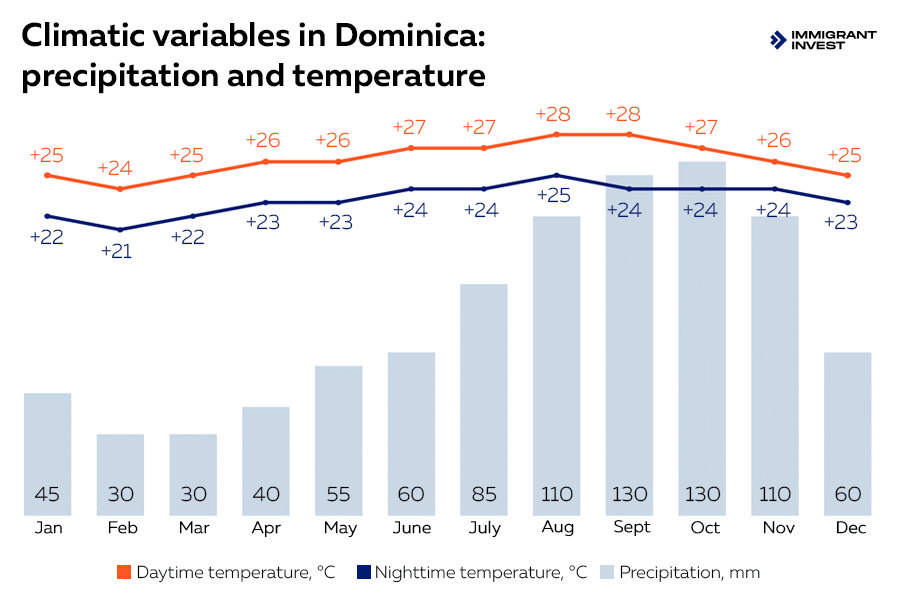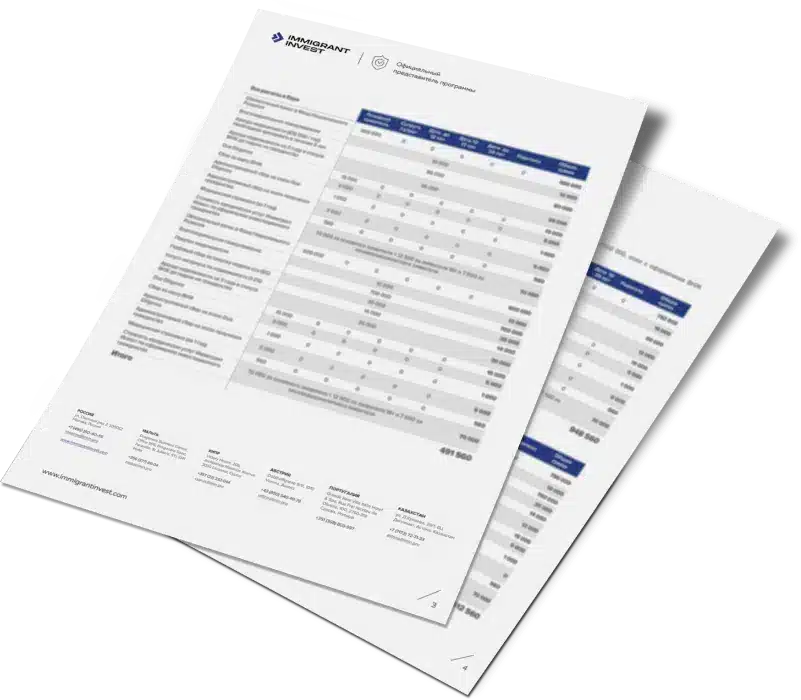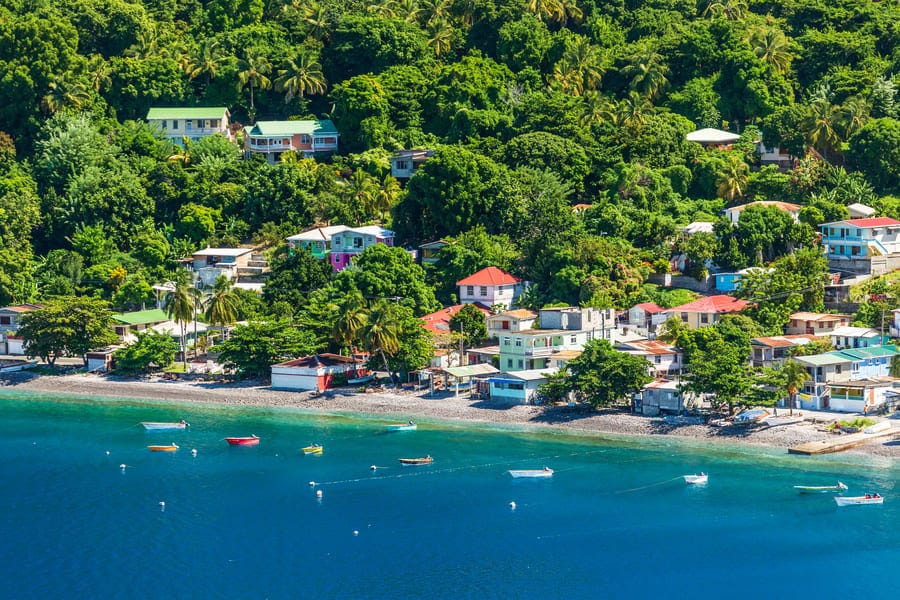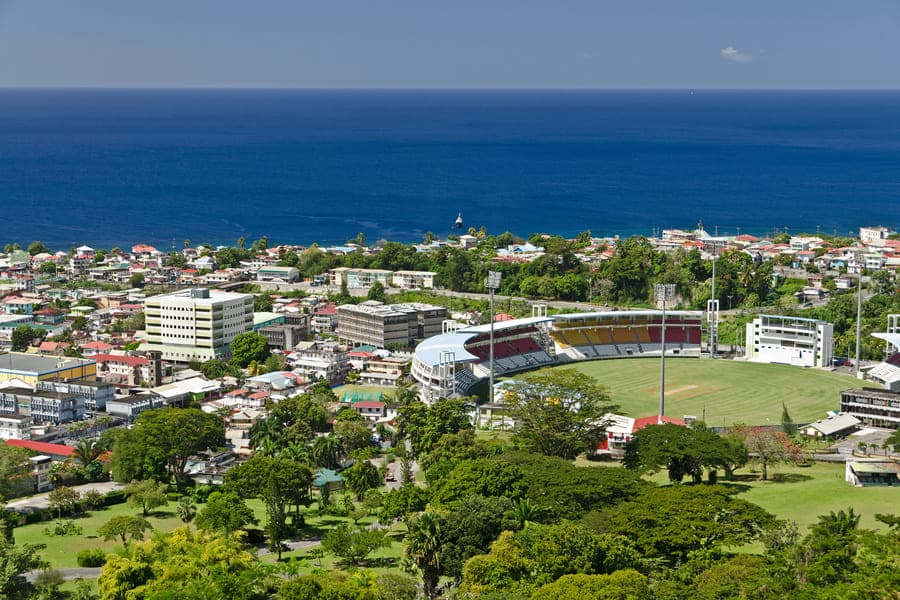Christopher Columbus was the one who informed the world about Dominica after encountering it on November 3rd, 1493. Until November 3rd, 1978, Dominica depended on the UK: first, it was a colony, then a protectorate.
Today, Dominica lives off tourism, fishing, agriculture and foreign investment. Expats and cosmopolitans choose Dominica citizenship to visit 144 countries visa-free, including Schengen Area, Singapore and Hong Kong.
Geography of Dominica
A tropical island state, Dominica is located in the eastern Caribbean Sea. The island belongs to the northern part of the Lesser Antilles archipelago. Previously, this area was known as the West Indies.
Dominica is mountainous and has a volcanic origin; hence, the dark, almost black sand on its coasts. To create a snow-white beach, the locals manually bring in imported sand.
All nine volcanos of Dominica are dormant. The most famous and high of them is Morne Diablotins: its peak reaches 1,447 m.
The island is approximately 47 kilometres in length and 29 kilometres in width. The terrain is arid in the western regions, but in the interior areas, long showers are frequent, so the soil is fertile.
The islands of Basse-Terre, Grande-Terre and Martinique are located near Dominica.
- Area — 751 km²
- Capital — Roseau
- Average annual temperature ― +27℃
- Most comfortable months — February, March, and April
- Approximate population — 72,000
- Official language — English
- National currency — Eastern Caribbean Dollar
Climate and nature of Dominica
The climate in Dominica is humid and hot. Northeast trade winds blow all year round. Heavy rains last from September to October. The average air humidity is 80%.
At the end of summer, hurricanes come to the island; some floods cause huge damage to the country.
The best months for visiting the island are February, March and April.

With the “Nature Island of the Caribbean” moniker, Dominica is known for its diverse flora and fauna.
Lush mountain rainforests, palm groves, and bamboo thickets are in the island's interior. Hundreds of animals and birds live here, including endemic species like the Imperial Amazon parrot.
The Morne Trois Pitons National Park is home to about sixty species of birds, bats, iguanas, boas, opossums and agouti rodents. A Dominica Crapaud can be encountered in the forests: it lives only on the Caribbean islands of Dominica and Montserrat.
Insects are abundant, but many prefer to live in the mountains, including the Hercules beetle, the "Cocuyo" Glowing Click beetle, fireflies, and various cockroaches and mosquitoes.
The coastal waters are rich in fish, crabs and turtles.
Political and economic structure of Dominica
Officially the Commonwealth of Dominica, the country is most commonly referred to as just Dominica. Because of its name, the country is often confused with the Dominican Republic. The latter is located on the same island as Haiti in the northern part of the Caribbean Sea, and Dominica is part of the Windward Islands in the eastern part of the Caribbean Sea.
Dominica is a parliamentary republic headed by a president. The Government exercises executive power. The Parliament elects the president for a five-year term. Nominally, the president is considered the head of the executive branch, but the real political powers are concentrated in the hands of the Prime Minister.
Legislative power is vested in the House of Assembly, a unicameral parliament. Sessions are held several times a year, and the interval between them does not exceed six months. Almost all decisions are made unanimously. An exception is voting on the president's impeachment, which requires only 2/3 of the votes.
The judicial system is part of one of the Eastern Caribbean States. The Eastern Caribbean Supreme Court is the higher authority. Dominica has four magistrates' courts and a High Court, which additionally serves as a constitutional court.
Dominica is a member of the British Commonwealth of Nations and many other international organisations, such as:
- the UN;
- CARICOM;
- the Organisation of American States (OAS);
- the World Trade Organisation (WTO);
- the Non-Aligned Movement (NAM);
- the African, Caribbean and Pacific Group of States (OACPS);
- the Alliance of Small Island States (AOSIS);
- and the Organisation of Eastern Caribbean States (OECS).
About 85% of the country's population is of African descent, and 9% are mixed-raced. The island is also home to descendants of the indigenous Caribs and a small percentage of European settlers.
The official language is English, but locals often use Creole, derived from French, in everyday life.
Dominica is a secular state. Most inhabitants are Christians — 94.4%, predominantly Catholics and Methodists. A small percentage of Dominicans identify with another religion, like folk beliefs (4.9%), Hinduism (0.1%) or Islam (0.1%), or atheists (0.5%).
The economy of Dominica develops thanks to fishing, agriculture, tourism, and the citizenship by investment program.
Dominica exports exotic fruits, spices and flowers, such as rare orchids. The main foreign trade partners are the UK, Jamaica, Antigua and Barbuda, France, Japan, and China.
Dominica produces coconut oil and soap and grows bananas, coconuts, bay trees and other fruits, which are also exported.

Volcanoes produce pumice stone, which is used in LOCAL construction. It is exported to the US and Europe with limestone, copper, and copra.
The tourism industry in Dominica brings significant income, so the government is investing in infrastructure and building earthquake-resistant buildings, hospitals, and hotels.
Dominica is committed to sustainable development and supports an eco-friendly lifestyle. The island uses the energy of natural resources: wind, water, sun and thermal springs.
The Citizenship by Investment Program in Dominica has been operating steadily since 1993. Thanks to the program, investments in tourism, infrastructure, social institutes, and ecology have been growing.
Infrastructure of Dominica
There are two airports in Dominica ― Douglas-Charles and Canefield. Both airports are located near Roseau, the capital of Dominica. They accept flights from the Caribbean. Passengers from the US, Europe, and Asia take connecting flights from other Caribbean states to get to Dominica.
The main road connecting the cities of Dominica runs along the island's coastline. Dirt roads are common in the interior part of the island, between small settlements.
In the north and south of Dominica, there are picturesque bays where ships can dock. Around twenty years ago, the island started to equip berths next to rocks and add customs services, repairs and refuelling, as well as tours around the island.
Foreign investors make a big contribution to the development of infrastructure. With the proceeds from the citizenship program, Dominica built a geothermal plant and earthquake-proof buildings and repaired schools, hospitals, and roads damaged by the 2017 hurricane.
Taxation in Dominica
Residents of Dominica do not pay taxes on capital gains, inheritances, or wealth. Personal income tax is imposed on a progressive scale of 0 to 15%, where the first $30,000 are not taxed.
Other basic taxes for individuals are the following:
- on property transfer — 1% is an assurance fee, and 2.5% is a judicial fee;
- stamp duty — 2.5% for the property seller and 4% for the buyer;
- social contributions — 6% of the salary.
The basic taxes for legal entities are the following:
- on global income — 25%;
- VAT — 15%;
- on property transfer — 1% is an assurance fee, and 2.5% is a judicial fee;
- stamp duty — 2.5% for the property seller and 4% for the buyer;
- social contributions — 7% of an employee’s wage.
Life in Dominica
Tourists and new residents of Dominica can integrate into everyday life by renting accommodations, shopping, riding public transportation, and joining local holidays.
Real estate and accommodations. You can buy or rent apartments, hotel suites, or villas in Dominica. A one-bedroom apartment rent starts at $240. Prices in Roseau, the capital of Dominica, are the highest.
Prices. In Dominica, prices are relatively low for the Caribbean region.
Approximate grocery prices in Dominica are the following:
- bread, 500 g — $2.10;
- milk, 1 l — $5;
- local cheese, 1 kg — $16;
- eggs, 12 pcs. — $4;
- chicken fillet, 1 kg — $4.6;
- apples, 1 kg — $9.25;
- bananas, 1 kg — $2.96;
- mid-range wine, 1 bottle — $9.70.
A couple can dine in a mid-range local restaurant for $60.
A monthly fitness club pass in Dominica costs about $62, and a movie ticket costs $9.25. A one-hour tennis court slot can be booked for $37 on the weekends.
Transportation. Minibuses run between Dominica localities: a one-way ticket costs around $1. City buses can be recognised by their license plates that start with "H".
Taxi in Dominica is charged per kilometre: the approximate price for 1 km starts at $2. Tourists can rent a car to drive around the island. To do that, they obtain a temporary driver’s license for about $15.
Ferries travel from Dominica to neighbouring Caribbean islands such as Martinique, Guadeloupe and Marie-Galante.
Healthcare in Dominica
Dominica is divided into seven health districts with 44 health clinics.
General taxes finance public healthcare services in Dominica. Primary care in government-owned medical facilities is free, but there are fees for services such as lab work or pharmaceuticals. The quality of local healthcare is above average.
There are five major hospitals in the country. Four are government-owned: Princess Margaret, Marigot, Grand Bay, and Portsmouth. The Princess Margaret hospital is the most advanced; it provides primary and secondary medical services and has a small ICU.
Private healthcare facilities in Dominica provide primary and secondary care. They are especially popular among expats and tourists who want faster and more advanced treatment. However, tertiary care is mostly available outside Dominica.
Visitors and residents of Dominica are urged to get international private medical insurance. It helps cover routine checkups, hospitalisation, dental, vision, and maternity care. Since medical emergencies in Dominica often require helicopter evacuation, most international plans cover it too.
Education in Dominica
Dominica has both public and private education systems. School is compulsory for all children between ages 5 and 16.
Public schools in Dominica aim to provide a higher level of primary and secondary education. There are more than 50 public schools in Dominica: the best ones are located in bigger cities and the capital.
Most preschools in the country are private: however, the government plans to introduce free kindergartens for children as young as two.
Tertiary education in Dominica is also divided into public and private. The main public establishments are:
- Dominica State College in Stock Farm. Offers two-year courses in arts, business, health, tourism, hospitality, sciences, and general studies.
- Open Campus of the University of the West Indies in Roseau. Offers a wide range of undergraduate, certificate, diploma, associate and bachelor-level programs in various fields.
Students with Dominica citizenship can enrol at colleges and universities in the UK and the Commonwealth States on preferential terms. They are also eligible for scholarships there.
All major private universities in Dominica are centred in Roseau or Portsmouth. They are:
- All Saints University School of Medicine.
- International University for Graduate Studies.
- New World University.
- St Joseph University.
- St Nicholas University School of Veterinary Medicine.
The All Saints School of Medicine is regarded as one of Dominica's most prestigious educational facilities. It is administered from Canada and accepts both local and international students. Local students get 50% scholarships. Clinical rotations are available worldwide, including hospitals in the UK, Canada, and the Caribbean.
The Institute of Tropical Marine Ecology was established on the island in 1999. It is located 15 km from Roseau. Since Dominica is one of the most eco-friendly countries in the Caribbean, the institute aims to take care of the island’s environment. The Institute’s staff collects weather data and studies tropical marine ecosystems.
Attractions, festivals, and entertainment in Dominica
Tourists come to Dominica to see the nature of the “greenest Caribbean island” and get acquainted with the local culture. Guided trips to local cities and villages help. Active leisure lovers will find an abundance of hiking, boating, horse riding and cycling routes on the island.
Attractions. Waterfalls are the most popular natural phenomenon on the island. Trafalgar Falls are sometimes called “twins” or “mother and father”. Roseau Falls are fast to reach and has a convenient trail leading to their pool. Locals visit the waterfalls to relax in the hot spring and jump off the rocks into the cold waters.
Morne Trois Pitons National Park, a UNESCO World Heritage Site, offers multiple famous attractions of Dominica: crater lakes, the Boiling Lake, Middleham Falls, rare tropical plants, and, of course, the Emerald Pool.
Dominica is home to 9 of the 16 volcanoes in the Caribbean. Morne Trois Pitons, Morne Diablotins, Morne Watt, and Morne Macaque are the most frequently visited ones.
The city of Roseau has preserved a quarter of its English colonial buildings. It is a pleasant place for walking and shopping. The city has a botanical garden, an art gallery, a fish market and a national museum.
The National Museum features the island’s economy, culture and history. Dominica Botanic Gardens has a magnificent tropical plant collection, and the fish market offers extremely affordable fresh seafood.
The old British-era Fort Shirley is at the northern end of Portsmouth Bay, and in Bataka, there is Kalinago Barana Aute, a traditional Carib village recreated for tourists.
Festivals and entertainment. Music and dance are important parts of Dominica’s culture. Independence Day is celebrated with a traditional song and dance festival. Seven days prior, World Creole Music Festival is celebrated for a week. World stars and local musicians like Francky Vincent and Ophelia Marie attend it. During the festival, Roseau becomes a world of calypso rhythms, dances and national clothing.
The Festival of Arts in Dominica runs from April to June. Local artists read stories and poems, play Creole music, and conduct master classes in documentaries, poetry, book illustrations, and sports journalism.
Dominica also hosts a diving festival and various sea sports competitions, which anyone can take part in, including tourists. The island has many gorges, arches and caves that were formed under the influence of underwater volcanoes. Over time, these places have become overgrown with corals, which can be viewed on an underwater tour.
Medical tourism enthusiasts flock to the tiny village of Wotten Waven in the south of Dominica. It has several spas and comfortable hotels with pools, therapeutic baths and hot springs.
Beaches. Dominica has fewer beaches than other Caribbean islands. One of the best is Champagne Beach, which is located near the town of Point Michel. The beach is known for its swirling waters. This effect is caused by the hot springs, which also make the water warmer. Tourists enjoy snorkelling and diving snorkelling near the beach.
Point Baptiste is another beautiful beach on the north coast of Dominica. It offers beautiful views of the red cliffs and Guadeloupe and Les Saintes islands. Point Baptiste has many coconut trees, which provide shade for tourists on hot days.
Food. Dominica’s cuisine is vibrant and varied. Residents grow legumes, rice, potatoes, and cassava. Cafes and restaurants serve assorted shellfish and baked fry, grilled agouti with spicy coconut milk and nutmeg sauce, meat stews, and soups with vegetables and fried bananas.
Dominica locals bake bread made from cassava, a root vegetable that replaces cereals. They love strong rum, local beer and fruit juices.
Interesting facts to know about Dominica
#1. Dominica is the youngest sister in the Caribbean family. Plinian volcano eruptions formed the island around 25,000 years ago.
#2. “Tall is Her Body”, or Wai’tukubuli, is the indigenous name of Dominica. This is what the native Kalinago people called their land before Christopher Columbus renamed it “Dominica”. His version translates as “The Sunday One” in Spanish since Colombus discovered the island on Sunday.
#3. The first ever long-distance hiking trail in the Caribbean was established in Dominica, named after Wai’tukubuli. The Waitukubuli National Trail stretches between Scott’s Head village and Cabrits National Park.
It takes around 15 days to hike through the entire 185 km of the trail. But it is also conveniently divided into segments with different categories of difficulty. No matter which segment you choose, spectacular views are guaranteed.
#4. The Kalinago craft industry is alive today and is fascinating. Dominica has the largest modern population of the Island Caribs, or Kalinago: around 3,000 people. They are trying to preserve their indigenous culture, and craftsmanship is one of the ways to do so.
Larouma baskets are the most popular example: they are woven from larouma reed and traditionally painted with natural dyes. You can buy them from local vendors.
#5. There are no poisonous or venomous spiders or snakes in Dominica. This makes hiking much more enjoyable for both tourists and residents.
Reptiles still can be encountered in the local tropical forest, and some may even bite if disturbed, but they pose no threat. Boa constrictor is the largest snake you may meet here: the locals call it “dog-head”, or “tête-chien”.
What are the advantages of a Dominica passport?
Dominica passport allows free entry to 144 countries, including the Schengen states, the EU, China, Singapore, and Hong Kong.
Dominica has its own citizenship by investment program. The program budget is highly transparent: the government regularly provides reports on income distribution.
Investment options are the following:
- $100,000+ is a non-refundable contribution that goes to the Economic Diversification Fund.
- $200,000+ is the purchase of the government-approved real estate.
Investors must hold the property for 3 years. But if the property is sold in 5 years, another participant of the citizenship program can buy it, and the demand for such real estate is higher.
During the holding period, investors can rent their property out for a 2—5% annual yield.
In addition to the investment, applicants pay stamp duties and administrative, Due Diligence, and document processing fees. The total amount will depend on what family members are included in the application.
Frequently Asked Questions
Dominica is located in the eastern Caribbean Sea, close to South America. The island belongs to the Lesser Antilles archipelago and is located in its northern part. Previously, this area was called the West Indies.
There are no direct flights to Dominica from anywhere but the Caribbean. To get to Dominica, passengers from the US, Europe, and Asia take connecting flights from other Caribbean states.
Not if you are a citizen of 144 countries with visa waiver agreements with Dominica. In that case, depending on your country of citizenship, you can spend up to 183 days in Dominica. The stay will usually be limited to 90 days within 180 days.
Dominica citizenship can be obtained by naturalisation, marriage or investment. The latter is the fastest way.
Investors, who participate in the citizenship program, have two options:
- $100,000+ is a non-refundable contribution that goes to the Economic Diversification Fund.
- $200,000+ is the purchase of the government-approved real estate.
The Dominica passport allows free entry to 144 countries, including the Schengen states, the EU, Singapore, China, and Hong Kong.
Dominica citizens can enrol their children at UK schools since Dominica is a member of the Commonwealth of Nations. Education is provided on preferential terms, and students are eligible for special scholarships.
Investors who become tax residents of Dominica can optimise their taxes. The country has no taxes on capital gains, inheritance and dividends.
Dominica is considered the greenest island in the Caribbean, so its main attraction is nature.
The island has many waterfalls and mountain rivers. Trafalgar Falls are sometimes referred to as “twins” or “mother and father”. Roseau Falls are fast to reach and has a convenient trail leading to their pool.
Morne Trois Pitons, Morne Diablotins, Morne Watt, and Morne Macaque are the most frequently visited volcanoes.
The National Museum features the island’s economy, culture and history. Dominica Botanic Gardens has a magnificent tropical plant collection, and the fish market offers extremely affordable fresh seafood.
Dominica’s main pride is the lush nature and the abundance of thermal springs, lakes, and waterfalls. It also has beautiful beaches with black volcanic sand, a warm ocean, and fascinating historical architecture.
Dominica preserves the culture of the native Kalinago tribe and adores music and arts: festivals and carnivals here are frequent.
Dominica also has a strong passport that allows free entry to 144 destinations, including the Schengen Area, the EU, Singapore, China, and Hong Kong. A Dominica passport can be obtained through the citizenship by investment program. The investment threshold is $100,000.
Yes, it is. Dominica is truly a tropical paradise, with one of the best natural landscapes in the Caribbean. It is also big in eco-friendly infrastructure.
Yes, and you can do so without a visa. Dominica citizens can visit countries in the European Union and the Schengen Area and spend 90 within 180 days there.

























 Zlata Erlach
Zlata Erlach